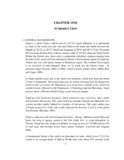Please use this identifier to cite or link to this item:
https://elibrary.tucl.edu.np/handle/123456789/3576| Title: | Impact of Dam on Fish Distribution in Kaligandaki River between Mirmee to Beltari [Dewater Zone] |
| Authors: | Somai, Shyam Bahadur |
| Keywords: | Fish distribution;Fisher communities |
| Issue Date: | 2011 |
| Publisher: | Central Department of Zoology |
| Institute Name: | Central Department of Zoology |
| Level: | Masters |
| Abstract: | The present study entitled “Impact of dam on fish distribution in Kaligandaki River between Mirmee to Beltari [Dewater zone]” was conducted from September 2009 to August 2010 in five sampling sites of Kaligandaki River namely Aandhimuhan, Aruwa Ghat, Chherlung Ghat, Dailatung Ghat and Beltari as site I, II, III, IV and V respectively with the aim to study the fish distribution and impact of dam on fish fauna along with the socio-economic condition of fisher communities of dewatered zone. The physic-chemical parameters were also analyzed with the mitigation measures of Kaligandaki-A Hydropower Project. Cast net, Ghorlang, Gill nets, “Duwalo Thunne”, hook and line were used for collection of fishes. Altogether 14 species of fishes under 3 orders, 6 families and 9 generawere caught during the study period. Among them, Barilius vagra and Barilius barila (Fageta) were found common in all sites while Labeo boga was found to be confined in sampling site I. Glyptothorax pectinopterus and Labeo bata were confined to sampling site II and III. Pseudoechinus sulcatus and Glyptothorax telchitta were only collected from site IV and V. Regarding the site wise fish composition 6 species under 4 genera were collected from the site I, 4 fish species under 3 genera from site II, 9 species under 6 genera from site III, 13 species under 9 genera from site IV and 9 species under 6 genera were captured from site V. After the construction of dam the water quality parameters are found to be changed. The impoundment resulted in the increase of water temperatures and also the increase in CO2 which ultimately resulted in the decrease in DO. These all results show the adverse effect in the normal growth of the fishes. Studying the impact of dam on fish resources, it was found that the construction, operation and maintenance of Project have given negative impact on several fish species. The migratory behavior of migratory fish were badly affected to up and downstream of the river. Mitigation measures like trapping and hauling, fish hatchery, cage culture, regular downstream release should be strictly implemented. Regarding the socio-economic condition, the fisher communities of the study area were found very poor and only 31.21% were literate. Their main occupation is fishing and boating but it is becoming in shadow. So some of the populations mostly young are compelled to take other secondary occupations like navigation, agriculture, labor and daily wage. |
| URI: | http://elibrary.tucl.edu.np/handle/123456789/3576 |
| Appears in Collections: | Zoology |
Files in This Item:
| File | Description | Size | Format | |
|---|---|---|---|---|
| Cover.pdf | 71.73 kB | Adobe PDF |  View/Open | |
| Chapter.pdf | 655.86 kB | Adobe PDF |  View/Open |
Items in DSpace are protected by copyright, with all rights reserved, unless otherwise indicated.
